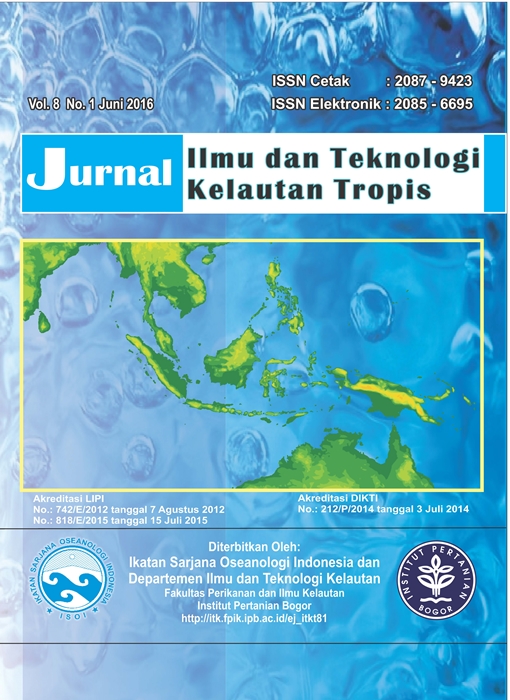OCEANOGRAPHY AND WATER QUALITY CONDITION IN SEVERAL WATERS OF THOUSAND ISLANDS AND ITS SUITABILITY FOR WHITE SHRIMP Litopenaeus vannamei CULTURE
Abstract
The purposes of this study were to determine oceanographic and water quality parameters and their suitability for white shrimp Litopenaeus vannamei culture. The measurements were carried out on dry season in Semak Daun Island, Karya Island, and Panggang Island waters of Thousand Islands, with areas of 315.0, 12.0, and 102.8 ha, water depth average of 4.6 m (0.5-28.1 m), 14.6 m (0.5-26.7 m), and 5.3 m (0.8-13.6 m), mean current water velocity of 12.9, 12.7, and 13.5 cm/second, respectively. In the study areas, we found a diurnal tidal pattern with high wave in January and July-August. Based on temperature, salinity, and water density in Semak Daun Island waters, there seemingly occurred a turn over indicating a good water circulation, while in Panggang Island and Karya Island waters tended to have a stratification. Generaly, water qualities in the study areas were in the op-timum range for white shrimp culture, i.e., temperature of 29.6-30.8oC, turbidity of 0.10-1.05 NTU, transparency of 5.8-9.7 m, total suspended solid of <8 mg/L, total dissolved solid of 20-164 mg/L, pH of 6.89-7.22, salinity of 32.2-32.3, dissolved oxygen of 5.8-10.8 mg/L, ammonia of 0.068-0.145 mg/L, nitrate 1.247-2.589 mg/L, and phosphate of 1.021-2.352 mg/L. Moreover, in Semak Daun Island wa-ters, we found the highest suitability for white shrimp culture due to its better water circulation.
Keywords: mariculture, coral reef waters, strait, water current, turnover, stratification.Authors
This work is licensed under a Creative Commons Attribution 4.0 International License.
Jurnal Ilmu dan Teknologi Kelautan Tropis i is an open-access journal, meaning that all content is freely available without charge to the user or their institution. Users are allowed to read, download, copy, distribute, print, search, or link to the full texts of the articles in this journal without needing to request prior permission from the publisher or the author.
All articles published by Jurnal Ilmu dan Teknologi Kelautan Tropis are licensed under the Creative Commons Attribution 4.0 International License. This allows for unrestricted use, distribution, and reproduction in any medium, provided proper credit is given to the original authors.
Authors submitting manuscripts should understand and agree that the copyright of published manuscripts is retained by the authors. Copyright encompasses the exclusive rights of authors to reproduce, distribute, and sell any part of the journal articles in all forms and media. Reproduction of any part of this journal, its storage in databases, and its transmission by any form or media is allowed without written permission from Jurnal Ilmu dan Teknologi Kelautan Tropis.


